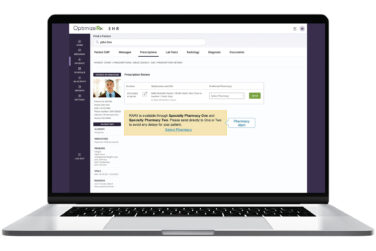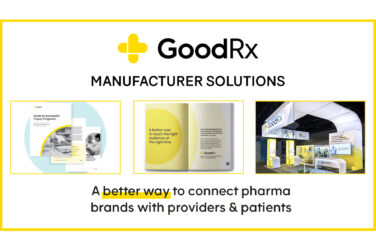“People adhere to medicines at a scale that should bewilder everyone in healthcare,” exclaims Grace Lomax, Clinical Director of Patient Connect, part of Clarivate. If you work in this industry and are not yet bewildered by the issue of medication nonadherence, allow Grace Lomax to put things into perspective.
“Only 8% of people taking ramipril—one of the most highly prescribed cardiovascular drugs in the world—are fully adherent over 12 months. Little wonder 70% of patients with hypertension remain hypertensive and therefore at risk of myocardial infarctions (MIs) and cerebrovascular accidents. When research shows one in three people die of an MI and these deaths start occurring from the age of 35, we should all take note. Furthermore, nearly 41 million people die prematurely each year from non-communicable diseases, yet 80% of these deaths could be avoided. Patient centricity/focus/advocacy buzzwords have come and gone—we need to stop talking and start listening to patients.”
Fortunately, it seems like more life sciences companies have started to adapt a real patient-centric approach since the pandemic, according to Emily Giegerich, Senior Vice President of Client Experience, imre.
“Previously, companies took a product-focused approach to their patient support services,” Giegerich explains. “The drug was in the middle, and things such as financial assistance, adherence, etc., surrounded it, all in service of the product and short-term needs. We’re now seeing more companies shift into a patient-directed approach, where the patient is at the top (not in the center) and is informing the decisions about things such as adherence, and programs are designed for the long term. This is important when it comes to adherence because there is no one way to tackle this problem. The approach to solving for forgetfulness should be vastly different than the approach for solving for financial burdens, but most companies group all nonadherence together.”
Building a Patient-First Adherence Strategy
So, what can companies do to better ensure their adherence programs are designed to serve patients’ needs? Providing more information about the treatment would be a good place to start.
“We can’t expect patients to stay on therapy if they don’t know why the therapy is important. In fact, according to a recent survey by PatientPoint and OnePoll, 55% of American consumers say they want to receive more detailed information from their HCP about treatment/medication for their condition,” says Melanie Spurrier, VP, Research and Analytics, PatientPoint. “One proven strategy to address the gap is to extend brand messaging into the doctor’s office or at the point of care. Blinded case studies comparing time on therapy of new-to-brand patients exposed to point-of-care messaging underscore the impact: A gastrointestinal brand saw a 44% increase in length of therapy for NBRx patients exposed to a brand ad in the waiting room and exam room versus control.”
Patient education is also an issue during clinical trials where Kyle Hogan, President of Datacubed Health, says the industry tends to depend more on data collection and analysis rather than patient engagement.
“Often there is a lack of clear and accessible information provided to the participants about the importance of medication adherence and its benefits for the trial,” Hogan explains. “This often leads to confusion which ultimately leads to disengagement, which in turn, leads to inaccurate trial data. By prioritizing patient engagement and education, the clinical trial industry will be able to foster better medication adherence and it’ll see a remarkable jump in effectiveness and reliability of clinical trials.”
Of course, adherence can be a complex issue and just helping patients understand the impact of taking their meds is not always enough.
“Many people struggle with adherence to therapy and it’s not simply because people don’t want to make that commitment,” explains Andi Weiss, VP, Behavioral Services, Evoke MicroMass. “Rather, success is contingent on a person making a series of decisions every day, some of which are conscious and others that have become ingrained habits. Figuring out how to ensure medication remains part of a routine in the face of barriers that may come up—both physical and psychological—is what leads to long-term adherence. That’s why solutions utilizing data-driven insights are needed to get at the actual cause of an individual’s adherence challenges.”
The Role of Data and Technology
To understand how impactful these types of data-driven solutions can be, let’s revisit clinical trials.
“Dosing support platforms available via everyday technology, such as a smartphone, empower patients to seamlessly report adherence in real time during trials,” explains Sondra Pepe, SVP, Product Management, AiCure. “Predictive adherence models can leverage two weeks of that adherence data to predict an individual’s adherence for the remainder of the study, and then ongoing data predicts their adherence for next week. Additionally, by observing and analyzing patient dosing behavior using AI, we can understand a patient’s daily dosing habits and lived experience with their disease to inform more targeted, proactive interventions before a dose is even missed.”
Other tech-enabled solutions that help with medication management and remote patient monitoring can also be effective; however, Gregory Gallo, Chief Revenue Officer, AdhereTech, says companies must consider certain factors when incorporating technology into adherence programs.
“In product or solution development, be mindful of social determinants of health (SDOH)/equity barriers that could limit patient participation or access,” Gallo explains. “Many patients/caregivers may not have easy internet access or competency navigating apps and passwords, so not ‘over-teching’ the solution with passwords, WiFi, or Bluetooth requirements allows programs to fit more seamlessly into a patient’s life and reduces adherence barriers. Ultimately, solutions must provide simple, clear communication to patients in real time to improve dose time accuracy, as well as easily escalate and solve challenges such as forgotten dose, cost, refill needs, dosing change, pauses, and side effects.”
Jake Yarbrough, Managing Director, Schaefer Advertising Co., agrees that simplicity is key and that means companies may need to re-think everything from product design to communications tactics to build the best possible adherence solutions for each patient.
“For example, we work with a product that monitors patients with diabetes for advanced warning of foot ulcers (to help avoid amputations),” Yarbrough explains. “This solution fits simply into any patient’s morning routine and only requires stepping on a bath-mat-sized device for 20 seconds. By ensuring all patient communication around the engagement with this device is equally simple, we have a much better chance of improving outcomes. Overall, we need to consider marketing tactics that help patients build a custom plan that suits their lifestyle while maintaining treatment goals. Bringing in patient advocates, leveraging AI for further customization, or integrating a holistic treatment journey design could all help patients build the best adherence plan for them.”









